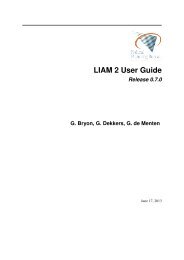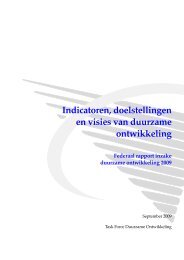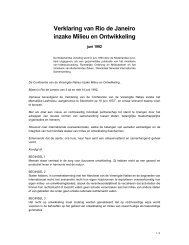long-term care use and supply in europe: projections for germany ...
long-term care use and supply in europe: projections for germany ...
long-term care use and supply in europe: projections for germany ...
You also want an ePaper? Increase the reach of your titles
YUMPU automatically turns print PDFs into web optimized ePapers that Google loves.
LONG-TERM CARE USE AND SUPPLY IN EUROPE | 31<br />
applies estimated probabilities of the variable of <strong>in</strong>terest (e.g. type of <strong>care</strong>) to the cell numbers, which<br />
are chang<strong>in</strong>g over time. The present model is static, <strong>in</strong> that it <strong>use</strong>s prevalence rates of LTC <strong>use</strong> (rates that<br />
<strong>in</strong>dicate the probability to <strong>use</strong> a particular type of <strong>care</strong> at a given moment <strong>in</strong> time) rather than <strong>in</strong>cidence<br />
rates (rates that <strong>in</strong>dicate the transition probability between types of <strong>care</strong>). The model takes account of<br />
variables that have been identified <strong>in</strong> Chapters 2 <strong>and</strong> 3 as the ma<strong>in</strong> drivers of LTC utilisation: age <strong>and</strong><br />
gender, the level of disability (number of limitations <strong>in</strong> activities of daily liv<strong>in</strong>g), ho<strong>use</strong>hold composition<br />
<strong>and</strong> a limited number of other relevant characteristics.<br />
The projection model broadly consists of two parts: 1) the distribution of the future numbers of older<br />
persons by age, gender, disability <strong>and</strong> other relevant characteristics (see section 4.1.1); 2) the application<br />
of estimated probabilities of us<strong>in</strong>g different types of LTC <strong>care</strong> to the projected population numbers <strong>in</strong><br />
each group, to produce projected numbers of <strong>care</strong> <strong>use</strong>rs (see section 4.1.2). The <strong>projections</strong> are made <strong>for</strong><br />
the 2010-2060 period at 5-year <strong>in</strong>tervals. Figure 4.1 provides a schematic overview of the projection<br />
model.<br />
Figure 4.1 Schematic overview of the projection model<br />
Projected numbers of persons 65+<br />
Groups by age (A), gender (G), disability (D), other (O)<br />
Logit model/prevalences residential <strong>care</strong> <strong>use</strong><br />
Numbers of persons resid<strong>in</strong>g at home by A, G, D, O<br />
Mult<strong>in</strong>omial model home <strong>care</strong> <strong>use</strong><br />
Numbers of<br />
persons<br />
us<strong>in</strong>g no<br />
LTC*<br />
Numbers of<br />
<strong>use</strong>rs of <strong>for</strong>mal<br />
<strong>care</strong> only*<br />
Numbers of <strong>use</strong>rs<br />
of <strong>in</strong><strong>for</strong>mal <strong>and</strong><br />
<strong>for</strong>mal <strong>care</strong>*<br />
Numbers of<br />
<strong>use</strong>rs of<br />
<strong>in</strong><strong>for</strong>mal <strong>care</strong><br />
only*<br />
Numbers of<br />
residential<br />
<strong>care</strong> <strong>use</strong>rs*<br />
* By A, G, D, O<br />
The current report is not the first to produce <strong>projections</strong> of LTC <strong>use</strong> <strong>for</strong> different European countries,<br />
us<strong>in</strong>g a st<strong>and</strong>ardised projection methodology. The 2003 European Study of Long-Term Care<br />
Expenditure, (Comas-Herrera et al., 2003 <strong>and</strong> 2006) presented <strong>projections</strong> of future numbers of LTC<br />
clients <strong>and</strong> future expenditures <strong>for</strong> Germany, Spa<strong>in</strong>, Italy <strong>and</strong> the United K<strong>in</strong>gdom, us<strong>in</strong>g cell-based or<br />
macro-simulation models. Based on a similar methodology, the European Commission <strong>and</strong> the Age<strong>in</strong>g<br />
Work<strong>in</strong>g Group have jo<strong>in</strong>tly conducted LTC projection exercises <strong>for</strong> the EU Member States, reported <strong>in</strong><br />
the successive reports on the budgetary impact of population age<strong>in</strong>g (Economic Policy Committee <strong>and</strong><br />
European Commission, 2005, 2006, 2008, 2009). At the time of writ<strong>in</strong>g, new <strong>projections</strong>, us<strong>in</strong>g the 2006<br />
projection exercise model, are be<strong>in</strong>g prepared, to be presented to the ECOFIN Council <strong>in</strong> May 2012<br />
(Economic Policy Committee <strong>and</strong> European Commission, 2011).<br />
The projection methodology proposed <strong>in</strong> the present study offers some advantages over the methods<br />
applied <strong>in</strong> the above-mentioned European studies. First, it is based on cross-nationally harmonized<br />
survey data (SHARE), us<strong>in</strong>g identical def<strong>in</strong>itions <strong>and</strong> measurements of the different types of <strong>care</strong> <strong>in</strong> all<br />
countries <strong>in</strong>volved. In contrast, the exist<strong>in</strong>g <strong>projections</strong> mostly rely on adm<strong>in</strong>istrative <strong>care</strong> utilisation<br />
data. Despite major ef<strong>for</strong>ts to improve the comparability of the LTC <strong>use</strong> data, the applied boundaries of
















